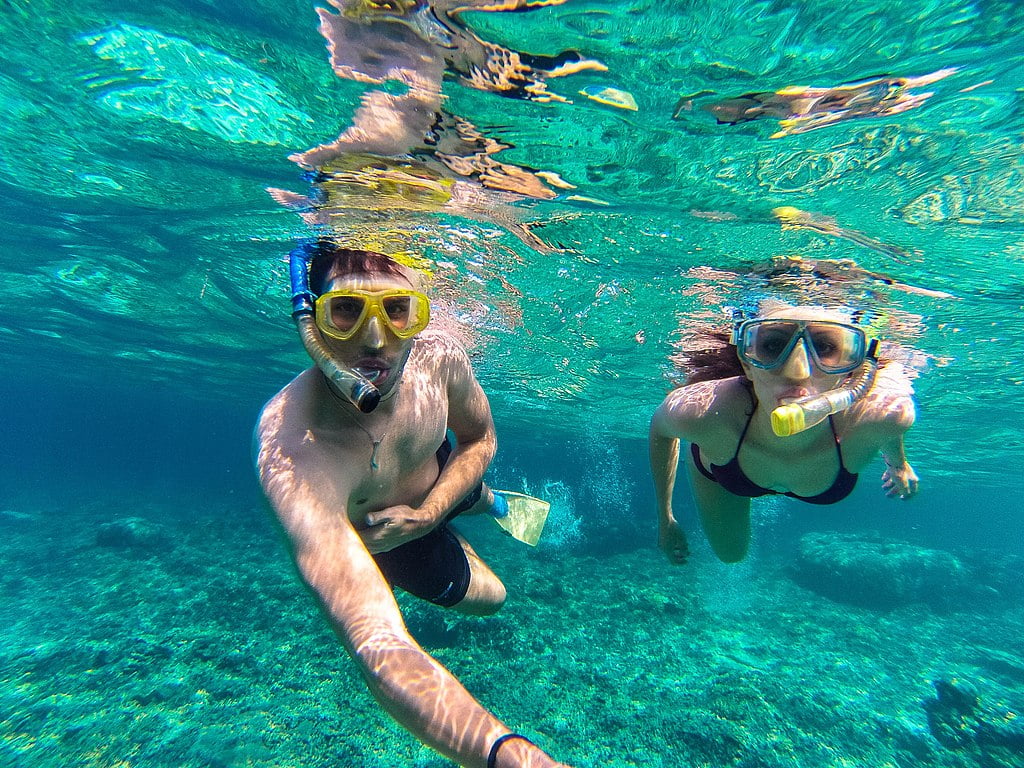Do you know what inspired Charles Darwin to write “the theory of evolution”, a powerful idea in explaining the evolution of life?
When Charles Darwin first stepped ashore the Galapagos archipelago in 1835, gazing upon her raw volcanic slopes and sun-baked rocks, he said, "The Galapagos are not just a collection of islands but a metaphor for the unity of life, I saw here a reflection of the universal bond that ties all living things."
That is how The Galapagos became synonymous with the birth of evolutionary Biology. The only place in the world known as “Living Laboratory of Evolution” or “Natural Museum”. Being one of Earth’s most biodiverse marine ecosystems, Galapagos Snorkeling offers you a rare opportunity to witness this aquatic paradise. Here finches, fur seals, sharks, penguins, iguanas and gigantic turtles are waiting as adventurous hosts.
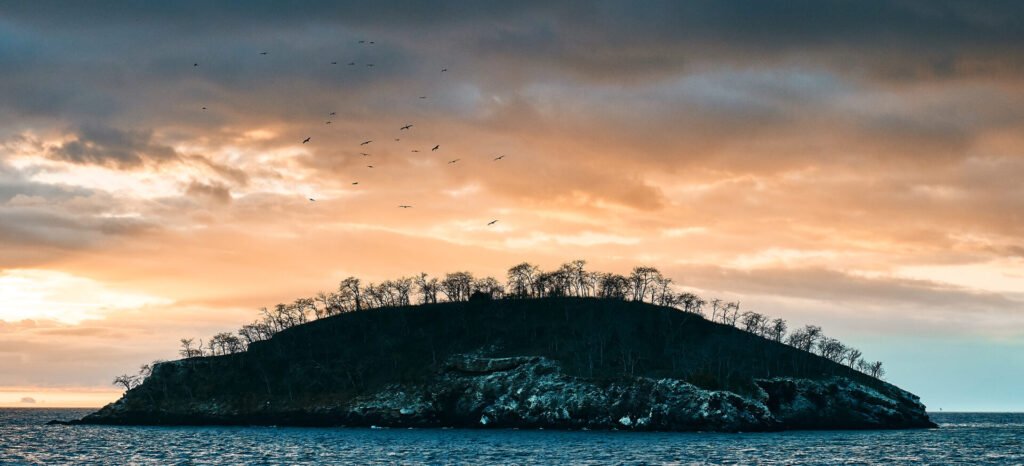
Why Galapagos Snorkeling?
The Galapagos Islands are a chain of islands, or archipelago, in the eastern Pacific Ocean. They are part of the country of Ecuador, in South America. The Galápagos lie about 966 kilometers (600 miles) off of the Ecuadorian coast. The Galapagos Islands are renowned for their volcanic landscapes and diverse ecosystems, both above and below the water’s surface. It is designated a Natural World Heritage Site in 1976. Galapagos Conservancy is a U.S. based nonprofit organization that works to protect this ecological treasure
Officially, there are more than 30 sites that allow snorkeling in Galapagos National Park. This island is not a coral reef snorkeling destination, Still hundreds of fish and invertebrate species live in the shallow. You are guaranteed to snorkel with sea lions, sea turtles, marine iguanas, and plenty of tropical fish. You also have a good chance of seeing a variety of rays and sharks (none dangerous), and even Galapagos penguins. The shallows waters are home to the king angelfish, butterflyfish, parrotfish, hogfish, the Pacific seahorse, octopuses, and starfish.
How to reach Galapagos
There are no direct International flights to the Galapagos, so you cannot fly straight to the Galapagos. Travelers must first arrive at mainland Ecuador prior to their flight to the Galapagos Islands.
- By Air:
- International Flights: Most international flights to the Galapagos depart from either Quito, the capital, or Guayaquil, the largest city in Ecuador. From Quito, you can then take a domestic flight to one of the two Galapagos airports: Seymour Airport on Baltra Island (GPS) or San Cristobal Airport (SCY) on San Cristobal Island.
- Domestic Flights: The Galapagos Islands have two main airports. Numerous domestic airlines operate flights from Quito or Guayaquil to the Galapagos. Some popular airlines include Avianca, LATAM, and TAME.
- On Average these flights takes around 2 hours 30 minutes one way. The trip price for a flight from Guayaquil to Galapagos is about $200. A flight from Quito to Galapagos is about $300.
- By Sea:
- Cruise Ships: There are occasional cruise options departing from the mainland. Check cruise schedules and plan accordingly.
- Travel Documentation:
- Passport Requirements: No visas are required for U.S., Canadian, and most European citizens unless you plan to stay more than ninety days.
Best time to visit the Galapagos
It is important to know when to plan your Galápagos snorkeling trip:
Hot Season: It runs from December to May. Temperatures range from 65 to 85 degrees. At this time of the year it is characterized by calm waters and tend to be warm. Snorkeling at this time of the year is perfect.
Dry Season: Runs from June to November. Temperatures range from 60 to 80 degrees. The waters at this time of year are cooler and a bit rougher due to the wind. But the rich underwater currents that arrive during these months, the marine life is more active.
Where to stay in the Galapagos
The Galapagos has four inhabited islands which offers hotel options: Santa Cruz, San Cristobal, Isabela, and Floreana. The other islands of the Galápagos archipelago are uninhabited and do not permit to stay overnight. Here are some popular options to consider for accommodations in the Galápagos:
- Santa Cruz: Finch Bay Galapagos Hotel (Luxury), Semilla Verde Boutique Hotel (Budget)
- San Cristobal: Galápagos Casa Playa Mann (Luxury), Eco Hotel Katarma (Budget)
- Isabela: Isamar Hotel (Luxury), The Isabela Beach House (Budget)
- Floreana: Black Beach House(Budget)
Weather in the Galapagos
Being on the equator and a tropical environment, you may be expecting the water in Galapagos to be warm. This is a big misconception. The Galapagos archipelago is strongly affected by two currents which impact water temperature and seasonality:
The Humboldt Current- flows north from Antarctica from June to November, bringing very cold streams of water that is filled with nutrients but downright frigid. The average water temperature during the cold & dry season that corresponds with the Humboldt current is 73°F (22°c) but can get as low as 66°F (19°c).
The Panama Current– flows south from December to June, bringing warm nutrient-poor streams to the Galapagos. The average temperature during this season is about 76°F (24°c).
This is why the Galapagos is known as an “Oasis of wealth in a desert of warm poor tropical waters”
Snorkeling gear
Snorkeling gear is not only practical but enhances the overall snorkeling experience. Most cruise companies provide their guests with masks, snorkels, and fins at no additional cost. But Its recommend bringing your own mask and snorkel for a comfortable fit. During dry season when water is cold, a wetsuit is must to enjoy Galapagos snorkeling!
Galapagos snorkeling map
Galapagos snorkeling spots
The most incredible thing about Galápagos snorkeling is coming face-to-face with fearless wildlife that shows no fear of humans. Galapagos snorkeling is the best opportunity to witness marine life in its purest form. Let us discuss the 11 most loved spots for Galapagos snorkeling:
Bartolomé Island
Of all the minor islands of Galapagos, Bartolome Island is the best. It is one of the “younger” islands in the Galapagos archipelago. It is estimated to be less than 1 million years old. It is more volcanic and barren compared to some of the older, greener islands. But its lava fields are home to a dedicated colony of Galapagos Penguins, Galapagos sea lions, marine iguanas and lava lizards. Bartolomé has an iconic view of the famous Pinnacle Rock with golden sand beaches and blue waters in the foreground. It’s one of the most photographed vistas in the islands.
1. Pinnacle Rock
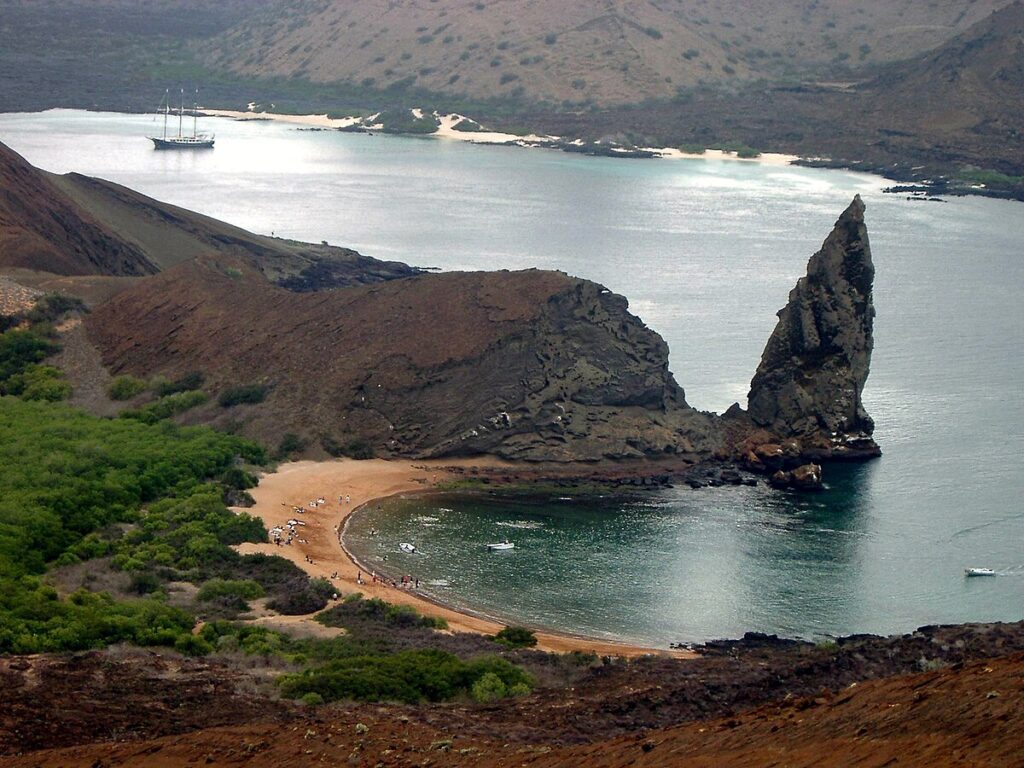
- Pinnacle Rock is a towering signature landmark located just off Bartolomé Island, rising over 300 feet straight out of the ocean
- It’s a volcanic structure at the edge of Playa Dorada on Bartolomé Island, rising out of the Pacific Ocean like a giant shark tooth
- The water in this crescent-shaped bay is calm and clear, and accessible directly from the shore making it a prime snorkeling location
- It is a great snorkeling site for less experienced swimmers as you can snorkel with schools of colorful fish just a few feet from the shore
- You can spot sea lions, penguins, marine iguanas, bright orange sally light-foot crabs, green sea turtles (they nest here)and lots of fish
- You may even spot white-tipped reef sharks(rarely aggressive towards humans) in the deeper water
Isabela Island
Isabela Island is the largest of the Galapagos formed by the joining of six shield volcanoes. Out of these six volcanoes two directly lie on the Equator. Isabela has more lagoons, bays, and inlets than any other Galapagos islands. It provides favorable breeding grounds for a rich marine life. Almost all of the animal species found throughout the Galapagos also exist on Isabela. It includes giant tortoises, penguins, marine iguanas, and flightless cormorants. This island is designated as a Ramsar Site in 2002.
2. Tagus Cove
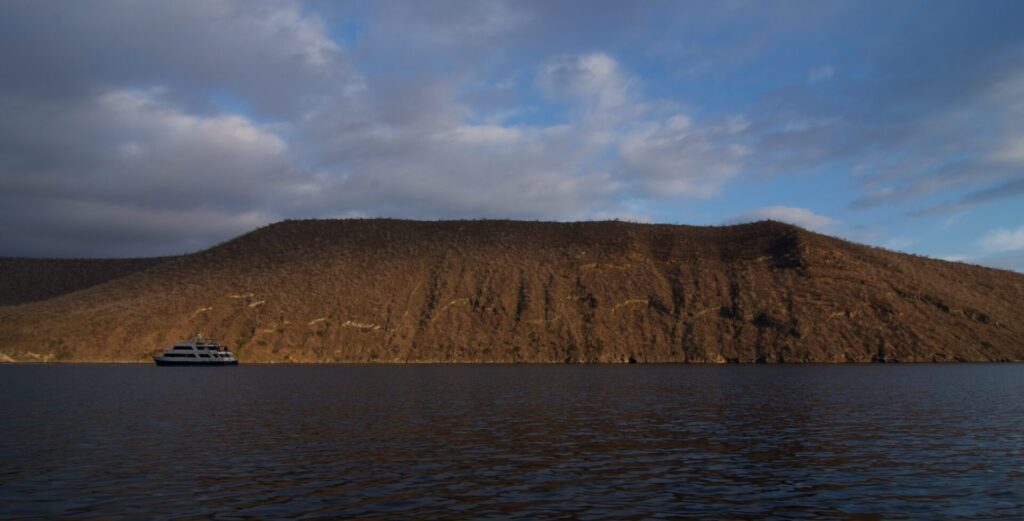
- Tagus Cove is a sheltered bay below Darwin lake, formerly used as a pirate’s hideaway and named after a British ship that visited Isabela Island in 1814
- The floor of the cove is covered with a swathe of green algae, giving it the appearance of a strange underwater pasture.
- The water here is shallow and impressively clear, making it easy to spot marine life
- Its nutrient-rich water attracts all kinds of marine life such as Galápagos penguins, sea lions, sea turtles, seahorses and, even port jackson sharks.
- There are also large numbers of starfish, sunfish and manta rays
- Tagus cove is also a great spot to go kayaking
3. Punta Vicente Roca
- Punta Vicente Roca is situated on the northwest tip of Isabela Island
- This site is comprised of two aquamarine coves made up of lava and ash from an active volcano
- Diversity of marine life attracted here due to the cold upwelling current . It is a great spot for deep-water snorkeling
- This site is also famous for deep sea diving
- Water temperature drops rapidly so wearing a wetsuit is recommended
- Nesting area for sea turtles, rays and sea birds. You can spot famous Mola Mola or commonly called “moon fish”
- due to good underwater visibility you can spot bullhead sharks, red-lipped batfish, seahorses, barracudas, green turtles, snappers, marine iguanas and manatee.
- It is one the few places to encounter with the rare port Jackson shark, a species of bullhead shark
Floreana Island
Floreana Island is located in the southern region of the Galapagos archipelago. Floreana has a population of around 100-150 people living in the only settlement of Puerto Velasco Ibarra. Tourism and fishing are the main economic activities. This island has several endemic species not found anywhere else, such as a subspecies of Galapagos mockingbird and rice rats. It was one of the first islands Charles Darwin visited during his voyage on the HMS Beagle in 1835. It is also the site of the first “post office”, established in 1793. One of the best Galapagos Snorkeling sites in the islands include Sea lions, reef sharks, sea turtles, hammerhead sharks, rays, many fish.
4. Devil’s Crown
- Devil’s Crown is an underwater volcanic cone located just off the northern shore of Floreana Island, formed by an underwater eruption
- It gets its name “Devil’s Crown” from its distinctive shape that resembles an underwater crown
- The volcanic cone is surrounded by coral formations and unique lava tunnels and caves that ocean life thrive in
- Strong ocean currents converge at Devil’s Crown. They attract large schools of tropical fish and making it one of the best snorkeling and diving sites in the Galapagos.
- You may spot wide diversity of fish, rays, sea lions, marine iguanas, Moray eels, surgeonfish, grunts, hammerhead sharks
- It’s best suited for more experienced snorkelers
Espanola Island
Española Island is located in the southernmost part of the Galapagos archipelago. It’s one of the oldest islands geologically. Española is the only place in the world where the Waved Albatross breeds and these large birds can be observed performing an elaborate courtship dance. The island is home to the Espanola lava lizard, a species found only on Espanola. This site will surely enhance your Galapagos snorkeling experience.
5. Gardner Bay
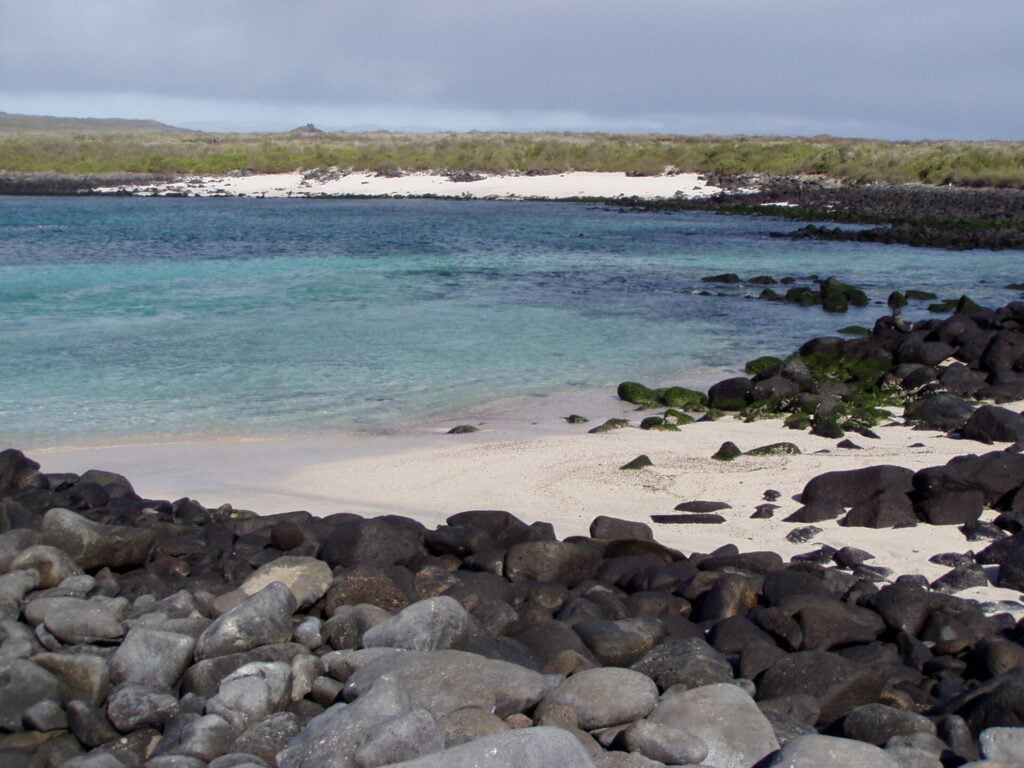
- Most visitors head to Española to see the waved albatross that nest here, still here is plenty more for the snorkeling
- Gardner Bay is one of the most beautiful beaches in Galapagos and an excellent place for snorkeling
- This is also a major nesting site for sea turtles
- This Beach is famous for its turquoise waters and white coral sand beach where herds of sea lions bask in the sun
- You can swim with reef white-tipped sharks, rays, green sea turtles and a variety of colorful reef fish
San Cristóbal Island
San Cristóbal Island is the fifth largest and the oldest in the archipelago. It is also famous for being the place where Charles Darwin first went ashore in 1835. The island is home to plenty of hotels, restaurants and souvenir shops catering to the large number of tourists. Like other Galápagos Islands, San Cristóbal is home to a diverse array of wildlife.
6. Kicker Rock
- Kicker Rock, also known as Leon Dormido, is a famous volcanic rock formation located off the coast of San Cristóbal Island
- In the middle of Kicker Rock is a narrow channel that splits it into two tall rock formations
- This channel is the reason Kicker Rock is such a popular site for both scuba diving and snorkeling
- visitors can swim through the channel alongside sharks, rays, and colorful tropical fish
- Thousands of seabirds nest on the cliffs of Kicker Rock, like boobies, frigatebirds and swallow-tailed gulls
- While snorkeling, people can spot and swim with sea turtles, eagle rays and white tipped reef sharks
- no prior experience is needed though moderate swimming ability is required
Fernandina Island
Fernandina is the third-largest and youngest of the Galápagos Islands. The island is an active shield volcano that has most recently erupted in January 2020. Due to its volcanic activity, Fernandina has a limited human footprint. The island is an important breeding ground for the Galápagos penguin, the only penguin species found north of the equator. snorkeling sites designated for tourists under the supervision of certified naturalist guides.
7. Punta Espinosa
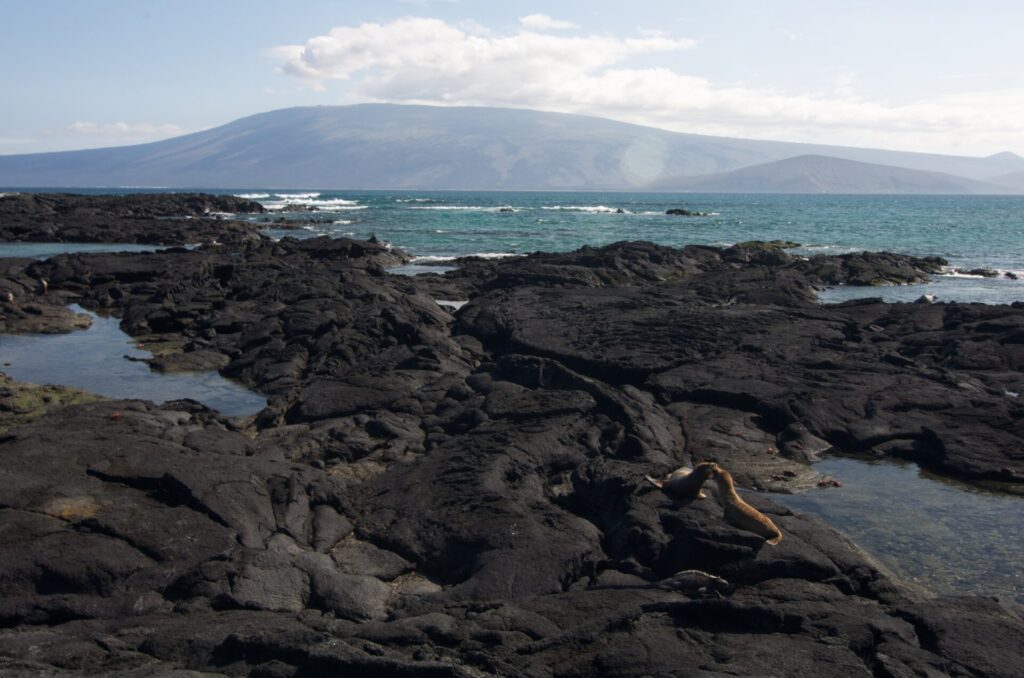
- This site is home to the largest colony of marine iguanas in the archipelago
- Charles Darwin nicknamed them -‘imps of darkness’, they most often can be found sunbathing on the volcanic rocks
- Snorkeling at Punta Espinosa is one of the most rewarding experiences in Galápagos snorkeling
- It offers the best snorkeling spot for seeing marine iguanas in the water
- You may spot sea lions, Galapagos penguins, sea turtles, rays and dolphins too
Santiago Island
Santiago, also known as James Island, is one of the central islands in the Galápagos archipelago. It is relatively small compared to other islands. The island shows a variety of volcanic formations, including lava flows, volcanic cones, and rocky terrain. Santiago Island is home to a variety of wildlife, both on land and in the surrounding waters. Turtle Cove, Sullivan Bay and Cousins rocks are main snorkeling spots.
8. Cousins Rock
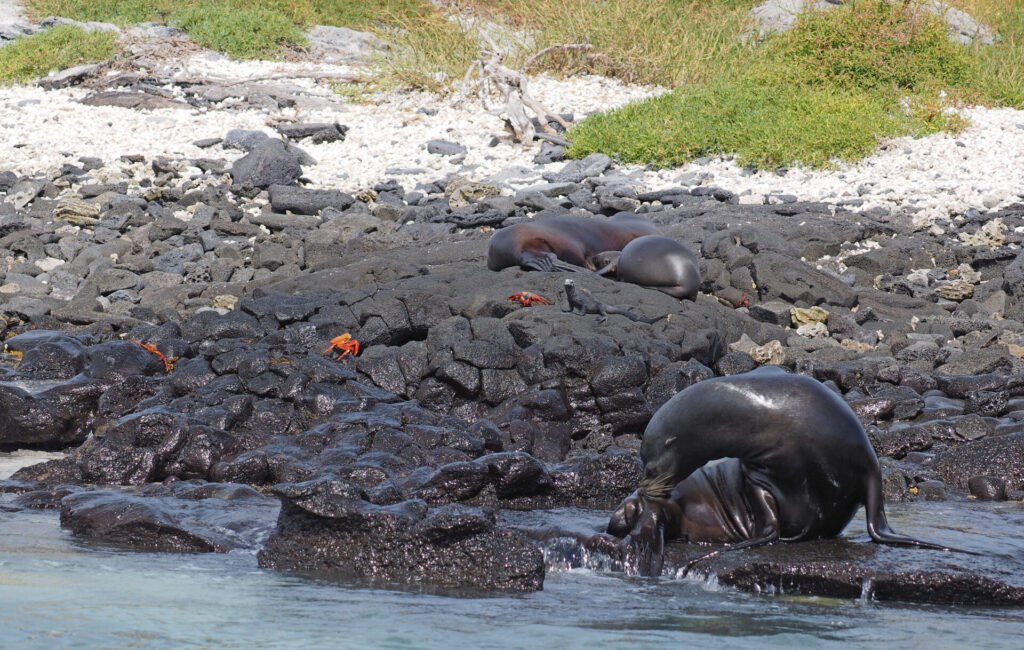
- It’s one of the most reliable year-round Galápagos snorkeling site – best suited for intermediate and advanced snorkelers
- provides the chance to witness a colorful underwater world with beautiful coral formations
- You will experience the magical endemic Galápagos black coral here
- site has average depth of depth 15mt with good visibility and moderate currents
- You may spot sea lions, fur seals, rays, turtles, and a myriad of vibrant fish as well as sea turtles, spotted eagle rays, manta rays, Galápagos sharks and white-tipped reef sharks
North Seymour Island
North Seymour is a small island located just north of Baltra Island. This island was formed by geological uplift and has rugged terrain made up of volcanic rock. North Seymour has no permanent human population, only park rangers and guides who come over from nearby Baltra Island. The island is a nature reserve and tourists can visit it on guided tours only. There are two small beaches on North Seymour, made up of coral sand. The island is home to a variety of bird species, including blue-footed boobies, frigatebirds, and swallow-tailed gulls. Some key fauna here include-marine iguanas, sea lions, Sally Lightfoot crabs, and various types of endemic Galapagos land and sea turtles.
9. Bachas Beach
- A trip to North Seymour Island will definitely include a snorkeling stop at either Mosquera or Las Bachas.
- Both of these locations offer some of the best sandy coral beaches fir for snorkeling
- Bachas Beach is known for its sea turtle nesting grounds, primarily of green sea turtles.
- The beach has gentle waters that make for good and safe snorkeling
- You may spot see sea lions, parrot fish, Mexican hogfish, surgeonfish, garden eels, and white-tip reef sharks.
Genovesa
Genovesa Island, also called Tower Island, is located in the northeastern part of the Galapagos archipelago. Almost all of Genovesa is a shield volcano that emerged from the ocean floor, leaving a rocky, eroded landscape. There are no land mammals, reptiles, or amphibians on Genovesa due to its remoteness and lack of vegetation. Only birds, insects, and marine life. It has some beautiful white sandy beaches like Philip’s Steps, where sea lions like to rest. The cliffs above the beaches offer good Galapagos snorkeling.
10. Prince Philip’s Steps
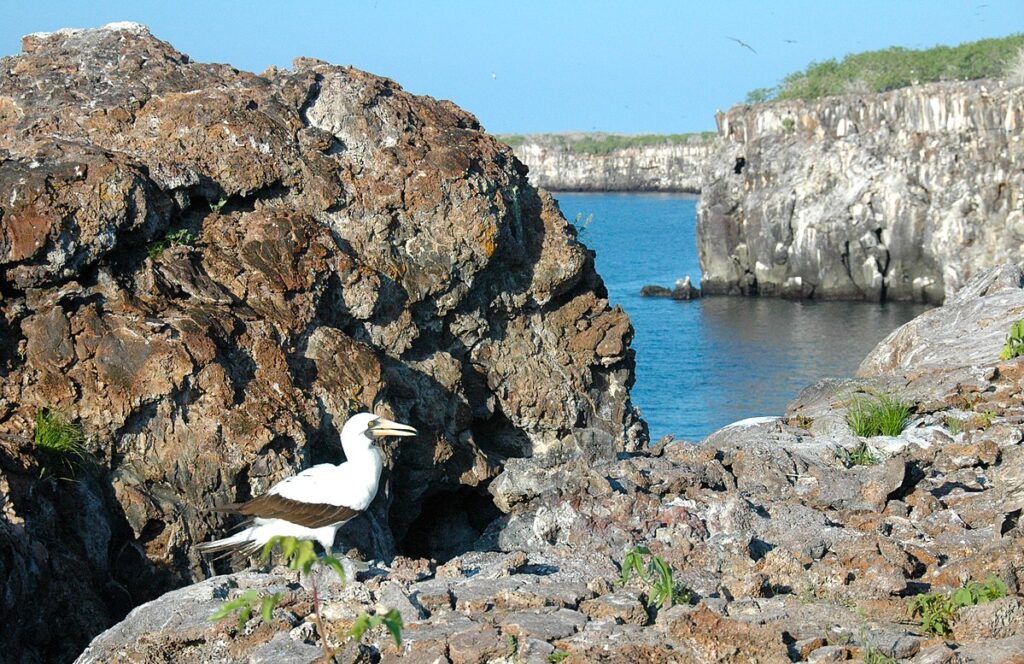
- Prince Philip’s Steps is located on the southern end of Darwin Bay.
- There are about 20 steep steps that stand around 10-12 feet in height each. The steps have formed jagged walls on either side
- The area is named after Prince Philip who visited the Galapagos Islands with Queen Elizabeth II in 1962
- Philip’s Steps are a popular stop for guided tours. The steps allow access to snorkel the coves around Darwin Bay which are filled with reef sharks, hammerhead sharks, rays, sea lions and other marine life.
Santa Cruz Island
Santa Cruz is the second largest island in the Galapagos and has the largest population, with over 15,000 residents. The Charles Darwin Research Station and the Galapagos National Park Service Headquarters are located on Santa Cruz. Activities like snorkeling, diving, surfing, hiking, and wildlife viewing make Santa Cruz a favorite stopover island for visiting tourists. Wildlife includes the famous Galapagos tortoises, land iguanas, vermillion flycatchers, Darwin’s finches, sea lions, marine iguanas, and more.
11. Tortuga Bay beach
- Tortuga Bay is situated on the southern coast of Santa Cruz Island and accessible by walking from Puerto Ayora through a marked trail
- The site is known for strong currents, it’s sometimes called the Washing Machine.
- Tortuga Bay is divided into two main parts: Playa Brava and Playa Mansa
- Playa Brava faces the open ocean and often has strong currents, making it suitable for experienced snorkelers.
- Playa Mansa, on the other hand, features calmer waters and is more suitable for swimming and snorkeling
- The Tortuga Bay beach is the best place to go snorkeling in Santa Cruz
- You should book your tour at least one day in advance
- You need a special permit from the National Park authority to fly a drone here
- You might spot lots of sea turtles, hammerhead sharks, spotted eagle rays, manta rays and lots of fish
Precautions & Tips for Galapagos Snorkeling
- Before landing to the Galapagos Islands you’ll need accomodation bookings and round flight tickets. This will be required at the airport to allow your entrance.
- Travel only with tour operators and/or boats authorized to work in the protected areas of Galápagos.
- Currents do flow strongly in places, making some sites better suited for experienced swimmers. It’s wise for beginners to start with a tour
- Travel only with tour operators and/or boats authorized to work in the protected areas of Galápagos
- If you are going to snorkel in the company of children. It is better to do it in shallow waters.
- Wearing a t-shirt or wetsuit while snorkeling helps to keep you warm, and stops sunburn your back
- It is important to stay in a group or together with a partner or guide during the activity.
- Galapagos marine animals are not usually dangerous or aggressive. However, it is preferable to keep a safe distance.
- Galapagos National Park rules dictate that you are not to come within 6 feet (2 meters) of wildlife
- Make sure you don’t bring any seeds, bugs or things that can alter the Galápagos environment
- Follow “leave-no-trace” principles in order to maintain the beauty of the environment
- Bring out all trash and dispose of in the populated areas or on your tour boat
- This is illegal to take back black coral, shells, lava rock, animal parts, or any native wood with you before leaving Galápagos
Frequently Asked Questions (FAQs): Galapagos Snorkeling
Q1: Can I Snorkel in the Galapagos Islands if I’m a Beginner?
A1: Absolutely! Many snorkeling sites in the Galapagos cater to beginners with calm waters and abundant marine life. Guided tours often include a briefing and assistance for those new to snorkeling.
Q2: Do kids enjoy the snorkeling?
A2: Absolutely – kids love spotting baby sea lions, Galapagos penguins, marine iguanas, sharks and schools of fish just off shore. It will create a lifetime memory bonding with exotic nature.
Q3: Is it Safe to Snorkel with Sharks in the Galapagos?
A3: Yes, it is generally safe to snorkel with sharks in the Galapagos. The species found in these waters, such as hammerhead sharks, white-tip reef shark are not aggressive towards humans.
Q4: Can we SCUBA dive?
A4: Yes, SCUBA diving is allowed but highly regulated with dive masters guiding all tours to protect ecosystems. Certification and previous experience required to dive here due to challenging conditions.
Q5: How else can I protect Galapagos wildlife?
A5: Follow all National Park rules-forbidding touching or disturbing animals and even give sea lions ample space when snorkeling near them. Using reef-safe biodegradable sunscreens. Make sure you don’t bring any seeds, bugs or things that can alter the Galápagos environment
Q6: Are There Night Snorkeling Opportunities in the Galapagos?
A6: Night snorkeling is not a common activity in the Galapagos due to safety reasons. However, some cruises offer special outings like “panga rides” where you can observe nocturnal marine life from the safety of a small boat.

